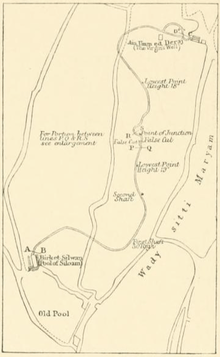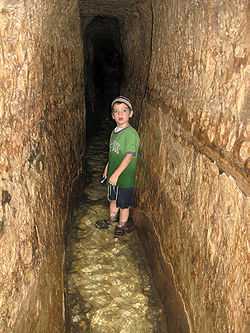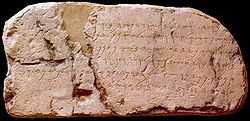Siloam tunnel

The Siloam Tunnel (Hebrew: נִקְבַּת השילוח, Nikbat HaShiloah), also known as Hezekiah's Tunnel, is a tunnel that was dug underneath the City of David in Jerusalem in ancient times. Its popular name is due to the most common hypothesis of its origin, namely that it dates from the reign of Hezekiah of Judah (late 8th and early 7th century BCE) and corresponds to the waterworks mentioned in 2 Kings 20:20 in the Bible.[1] According to the Bible, King Hezekiah prepared Jerusalem for an impending siege by the Assyrians, by "blocking the source of the waters of the upper Gihon, and leading them straight down on the west to the City of David" (2 Chronicles 32).
Support for the dating to Hezekiah's period is derived from the Biblical text that describes construction of a tunnel[1] and to radiocarbon dates of organic matter contained in the original plastering.[2] However, the dates were challenged in 2011 by new excavations that suggested an origin in the late 9th or early 8th century BCE.[3][4]
The tunnel, leading from the Gihon Spring to the Pool of Siloam,[5][6][7] was designed as an aqueduct to provide Jerusalem with water during an impending siege by the Assyrians, led by Sennacherib. The curving tunnel is 533 m long, and by using a 30 cm (0.6‰) gradient altitude difference between each end, conveyed water along its length from the spring to the pool.
According to the Siloam inscription, the tunnel was excavated by two teams, one starting at each end of the tunnel and then meeting in the middle. The inscription is partly unreadable at present, and may originally have conveyed more information than this. It is clear from the tunnel itself that several directional errors were made during its construction.[8] Recent scholarship has discredited the idea that the tunnel may have been formed by substantially widening a pre-existing natural karst.[2]
The difficult feat of making two teams digging from opposite ends meet far underground is now understood to have been accomplished by directing the two teams from above using sounds generated by hammering on the solid karst through which the tunnelers were digging.[2]
Discovery and interpretation

The tunnel was first described in modern times by Franciscus Quaresmius in 1625.[9] It was later explored in 1838 by the American biblical scholar Edward Robinson,[9] and in 1865 by Charles Warren.[10]
Neither Quaresmius nor Robinson identified the tunnel with Hezekiah,[9] but in 1871 Warren suggested that the Pool of Siloam may have been "dug by King Hezekiah"[11] and in 1884 following the discovery of the Siloam inscription wrote that: "The inscription thus appears to belong to the later period of the Hebrew monarchy, and may very well be considered to agree with the Biblical account of Hezekiah's preparations for Sennacherib's siege"[12]
Function and origin
The ancient city of Jerusalem, being on a mountain, is naturally defensible from almost all sides, but suffers from the drawback that its major source of fresh water, the Gihon spring, is on the side of the cliff overlooking the Kidron Valley. This presents a major military weakness as the city walls, if high enough to be defensible, must necessarily leave the Gihon spring outside, thus leaving the city without a fresh water supply in case of siege.
The Bible says that King Hezekiah (c. 8th century BC), fearful that the Assyrians would lay siege to the city, blocked the spring's water outside the city and diverted it through a channel into the then Pool of Siloam.[13] However, it is now known (as of 1997) that the earlier Warren's shaft system had already heavily fortified the Gihon Spring;[14] Warren's shaft is not an aqueduct, and requires those desiring water to travel up and down it themselves - an arrangement that Hezekiah seemingly must have considered inadequate.
In 1899, an ancient channel, also leading from the Gihon Spring to the Siloam Pool area, but by a more direct route, was found. This channel is now known as the Middle Bronze Age channel, on account of its estimated age. Ronny Reich determined that it was constructed around 1800 BC (in the Middle Bronze Age), and thus that the spring's water had already been diverted many centuries before Hezekiah. As originally constructed, it is understood as a 20 feet deep ditch in the ground, covered over by large rock slabs (which were then hidden in the foliage). It is narrower than the tunnel, but can still be walked by a human for most of its length. In addition to the (3 ft high) exit near the Siloam pool, the channel has several small outlets that watered the gardens facing the Kidron Valley.[15] Hezekiah's tunnel was constructed to replace this channel, since a besieging army could fairly easily have discovered and destroyed the Middle Bronze Age Channel.
Biblical interpretation
The Bible verses relating to a tunnel Hezekiah's time are these:
"As for the other events of Hezekiah’s reign, all his achievements and how he made the pool and the tunnel by which he brought water into the city, are they not written in the book of the annals of the kings of Judah?" 2 Kings 20:20
"When Hezekiah saw that Sennacherib had come and that he intended to wage war against Jerusalem, he consulted with his officials and military staff about blocking off the water from the springs outside the city, and they helped him. They gathered a large group of people who blocked all the springs and the stream that flowed through the land. 'Why should the kings of Assyria come and find plenty of water?' they said." 2 Chronicles 32:2-4
"It was Hezekiah who blocked the upper outlet of the Gihon spring and channeled the water down to the west side of the City of David. He succeeded in everything he undertook." 2 Chronicles 32:30
"You also saw the City of David, that it was great; And you gathered together the waters of the lower pool. You also made a reservoir between the two walls for the water of the old pool. But you did not look to its Maker, Nor did you have respect for him who fashioned it long ago" - Isaiah 22:11
Doubts over dating

Excavation work in the tunnel by Ronny Reich of the University of Haifa and Eli Shukron of the Israel Antiquities Authority has cast doubt over the attribution of the tunnel to the reign of Hezekiah.[3] They believe the evidence points to a date several decades earlier, in the last part of the 9th century or early part of the 8th century.[3] They note that the biblical passage connecting Hezekiah to the construction of waterworks doesn't specify a place in the city, and suggest it might refer to waterworks in the Mamilla area.[3]
The revised dating is supported by De Groot and Fadida on the basis of pottery analysis.[4]
See also
| Wikisource has the text of the 1897 Easton's Bible Dictionary article Fountain of the Virgin. |
- List of artifacts significant to the Bible
- List of caves
- Siloam inscription
- Tunnel of Eupalinos, 6th century BC tunnel on Samos, Greece
- Warren's Shaft
- Fountain of the Virgin
References
- ↑ 1.0 1.1 Robb Andrew Young (2012). Hezekiah in History and Tradition. Koninlijke Brill. pp. 35,48–50.
- ↑ 2.0 2.1 2.2 Frumkin, Amos; Shimron, Aryeh (2006). "Tunnel engineering in the Iron Age: Geoarchaeology of the Siloam Tunnel, Jerusalem". Journal of Archaeological Science 33 (2): 227–237. doi:10.1016/j.jas.2005.07.018.
- ↑ 3.0 3.1 3.2 3.3 Ronny Reich and Eli Shukron (2011). "The date of the Siloam Tunnel reconsidered". Tel Aviv 38: 147–157.
- ↑ 4.0 4.1 Alon De Groot and Fadida Atalya (2011). "The Pottery Assemblage from the Rock-Cut Pool near the Gihon Spring". Tel Aviv 38: 158–166.
- ↑ Image of exit
- ↑ Holy Land Photos
- ↑ Image
- ↑ Images of some mistakes -
- ↑ 9.0 9.1 9.2 Robinson, Edward; Smith, Eli (1841). Biblical Researches in Palestine, Mount Sinai and Arabia Petraea: A Journal of Travels in the year 1838. Boston: Crocker & Brewster. p. 337.
- ↑ Warren, Charles; Wilson, Charles William; Stanley, Arthur Penrhyn (1871). Morrison, Walter, ed. The recovery of Jerusalem: a narrative of exploration and discovery in the city and the Holy Land. New York: D. Appleton. p. 194.
- ↑ The recovery of Jerusalem, by Captain Warren, quote: "This latter I suppose to have been the pool dug by King Hezekiah"
- ↑ The survey of Western Palestine-Jerusalem (1884) p.348, Warren and Conder
- ↑ Holy Land Photos
- ↑ image of the (remains of the) fortifications
- ↑ Images of the Middle Bronze Age channel
Bibliography
- Brisco, Thomas C. (1998). Holman Bible Atlas. Nashville: Broadman & Holman Publishers. ISBN 1-55819-709-5.
- Frumkin, Amos; Shimron, Aryeh (2006). "Tunnel engineering in the Iron Age: Geoarchaeology of the Siloam Tunnel, Jerusalem". Journal of Archaeological Science 33 (2): 227–237. doi:10.1016/j.jas.2005.07.018.
- David Ussishkin, The Original Length of the Siloam Tunnel in Jerusalem , Levant 8, 1976, pp. 82-95
- Rogerson, J., Davies, P. R., Was the Siloam Tunnel Built by Hezekiah?, Biblical Archaeologist 59, 1996, pp. 138–49.
- Rosenberg, S., The Siloam Tunnel Revisited, Tel Aviv 25, 1998, pp. 116–30.
- Frumkin, A., Shimron, A., and Rosenbaum, J., Radiometric Dating of the Siloam Tunnel, Nature 425, Jerusalem, 2003, pp. 169–71.
- Amihai Sneh, Ram Weinberger, Eyal Shalev, The Why, How, and When of the Siloam Tunnel Reevaluated, Bulletin of the American Schools of Oriental Research 359, August 2010, pp. 57-65
- Ronald S. Hendel, The Date of the Siloam Inscription: A Rejoinder to Rogerson and Davies, Biblical Archaeologist, 1996, vol.59
- Shlomo Guil A New Perspective on the Various Components of the Siloam Water System in Jerusalem
External links
| Wikimedia Commons has media related to Hezekiah's Tunnel. |
- The Siloam TunnelAqueduct in the Jewish Encyclopedia
- Hezekiah's tunnel BiblePlaces.com article containing photos & links
- A Tiny Piece of the Puzzle: Six-Letter Inscription Suggests Monumental Building of Hezekiah Biblical Archaeology Review
- City of David City of David archeological site
- Christian video of the tunnel on YouTube
- Hezekiah’s Tunnel: Living proof of God’s greatness
Coordinates: 31°46′20″N 35°14′08″E / 31.772358°N 35.235673°E